Contributed by Mr. Edward Wightman, Former Research Intern and Student at Rutgers, The State University of New Jersey
The World War Two era was a period of great change not only in the United States but in the world. The war itself directly impacted the world with massive destruction and innumerable lives lost. The aftermath of the war saw the return of thousands of soldiers to the United States all hoping to take advantage of the G.I. Bill and its benefits and pursue higher education at universities throughout the country and Seton Hall was one of these many Universities that experienced this influx of new students returning on the G.I. Bill.
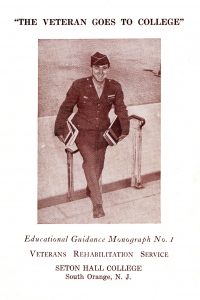
The Seton Hall student newspaper The Setonian gives us insight into the impact of the war on students and student life on campus although this source is limited as The Setonian was not running during the years of American involvement of the war despite the university being open. Despite this limitation The Setonian does provide excellent information about the period before and immediately after the war at Seton Hall. In the years leading up to the war there were a number of articles published that ask students about the threat of the rise of Communism, and if students think there will be another large scale global war. The Setonian also has a number of articles detailing the many different student organizations that are promoting peace among world powers including the Pax Romana organization and the Catholic Student Peace Federation. The articles tell us that there were many groups of students in the years between the two World Wars who were advocates of peace and hoped their movement could prevent another great war.
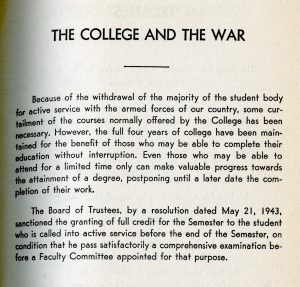
One of the other interesting areas that is briefly mentioned in The Setonian is the opinion of then Seton Hall the Rev. Msgr. James F. Kelley on the rise of both Communism and Facism throughout Europe. An article in The Setonian dated to March 23, 1937 describes President Kelley’s address at the Eighty First Feast of St. Joseph, during this address Re. Msgr. Kelley expresses his opinion as well as the opinion of the Catholic Church on Communism and its rise. There also is an article documenting a movement by students supporting the Catholic War Veterans of America’s campaign against communism in the United States. The pre war years at Seton Hall as documented by The Setonian depict a level of concern among students about the growing threat of Communism and the fears of another global conflict that were fears shared by many Americans at the time.
The Second World War began September 1, 1939 with the Nazi German invasion of Poland followed by the declaration of war on Germany by France and Britain on September third. The United States would later enter the war following the December 7, 1941 Japanese attack on Pearl Harbor and the subsequent declaration of war on the United States by Nazi Germany on December 11, 1941. As many universities would experience Seton Hall saw a vast majority of its students leave to serve in the war. It was at this time that The Setonian did not run as there were not enough students to run the paper so we have a very limited knowledge of what student life and activity was like at Seton Hall during the years of the war.
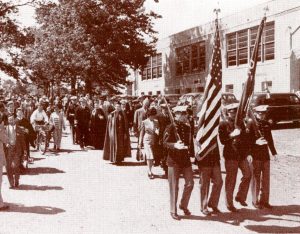
The end of World War Two on September 2, 1945 led to the return of the many thousands of soldiers to the United States. These soldiers would be given many benefits under the Servicemen Readjustment Act of 1944, also known as the G.I. Bill. This bill provided returning soldiers with a number of benefits and among these was the ability to pursue a degree at a college or vocational school with tuition paid for by the government. This section of the bill led to an influx of new students at universities throughout the United States and Seton Hall experienced this first hand. The return of students to Seton Hall also brought the return of the student newspaper The Setonian which documented the impact of the students returning to school and those who were pursuing educations on the G.I. Bill. In the aftermath of the war a new column was started in The Setonian called “veteran’s corner” which was a dedicated column providing information for all veterans on campus regarding all manner of topics. We also see a number of articles that describe some of the issues faced by Seton Hall in the post-war period such as shortages of housing and food for the increasing numbers of students among other issues.
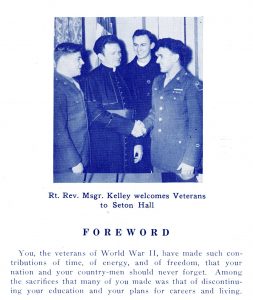
The Setonian is a very valuable resource for understanding the aftermath of World War Two and the impact of the G.I. Bill on universities. The many articles published at this time especially those in the “Veteran’s Corner” column are invaluable in providing information about what life was like for returning veterans, and what they were provided with while attending Seton Hall. We also see other articles outside of the “Veteran’s Corner” column discussing the influx of veteran students one such article is titled “Plan For Vets” from March 13, 1946 which is an article that discusses the plan by Seton Hall to manage the influx of veterans at the school and its plans to assist them. Another article is found in the “National College News” column which on November 3, 1946 published an article discussing the problems faced by universities throughout the nation including housing shortages as well as food shortages due to so many new students on the G.I. Bill and those students bringing their families to school with them.
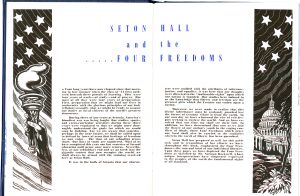
The World War Two era was a time of great flux for universities throughout the United States as student attendance numbers rapidly decreased during the years of American involvement in the war, and then rapidly increased to all time highs in the years following the war. Seton Hall was among these universities who experienced this impact tremendously, as it faced the challenges of losing many students to the war, and then the challenges of the large number of students pursuing education on the G.I. Bill.
